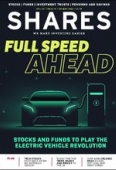Archived article
Please note that tax, investment, pension and ISA rules can change and the information and any views contained in this article may now be inaccurate.
How to test the market mood

In many ways right now, it looks like business as usual for the financial markets.
Blow-out quarterly numbers from Google’s parent Alphabet, Apple and Facebook are taking their share prices to new highs and carrying the Nasdaq index along with it. The FTSE 100 is having another crack at breaking through the 7,000 barrier and central banks seem in no rush to switch off the hose of cheap liquidity with which they are dowsing markets (unintentionally or otherwise).
And yet, as discussed in the previous iteration of this column, bonds are trying to rally, as is gold. This move in haven assets seems at odds with the prevailing optimism regarding global vaccination programmes, an economic upturn and higher corporate profits and dividends.
It can be easy to read too much into such short-term moves, as nothing goes up or down in a straight line. Instead, one way to test the market mood is to check out what is going on at the periphery, as that is where investors are taking the most risk and therefore the asset classes and holdings they are most likely to liquidate first in the event that bullish sentiment starts to ebb.
Another is to look at the market darlings, the areas that are doing or have done best and are garnering the most coverage, from analysts, press and commentators alike. If they are keeping on running, then all may still be well. If not, this may be the first inkling of trouble ahead, or at least a shift in the market mood.
CRYPTIC MESSAGE
Markets have done a good job of shrugging off the failures of Greensill Capital and hedge fund Archegos in March, and experienced investors will remember markets kept rising after the first two Bear Stearns property funds collapsed in June 2008. However, it did not take long for deeper problems to appear, so investors must remain vigilant, especially as there are some signs that some of the hottest areas are starting to cool.
This can, for example, be seen in the fortunes of both bitcoin and special purpose acquisition companies, a phenomenon that has gripped the US market in particular. The Next Gen Defiance SPAC Derived ETF, which tracks a basket of over 200 SPACs is down by more than a third from its high.

This is perhaps less of a surprise when you consider the data from SPACinsider.com which shows how 308 SPACs are looking for a target even though 263 have already floated. In the end, supply may be outstripping demand.
Setbacks in bitcoin are nothing new and cryptocurrency supporters will be unperturbed but the way the performance of IPOs (initial public offerings) is tailing off around the world is worthy of note.
Perhaps the quality of deals is going down as the prices are going up, or, again, supply is starting to catch up with demand although Darktrace (DARK) is off to a good start, at least.

ELECTRIC SHOCK
There can be no better proxy for the current bull market that Tesla. Yet even Elon Musk’s charge is losing a bit of its power to impress and that is weighing on another momentum favourite, Cathie Wood’s ARK Innovation ETF, a $22 billion tracker fund which aims to deliver the performance of 58 tech and growth stocks.

Even that classic gauge of both market sentiment and economic activity, small-cap stocks, are pausing for breath, although America’s Russell 2000 is yet to roll over.
All of this could be healthy. Again, nothing goes up in a straight line and some of these assets and securities were looking bubbly, at least in the eyes of some. A cooling off may be no bad thing.
Equally, it could be a sign that markets are moving on. Frontier and emerging markets still look to be showing upward momentum, a trend that would fit with the narrative of a global economic recovery and bullish investor sentiment – few areas are more peripheral than frontier arenas such as Vietnam, Morocco, Kenya and Romania.
As such, we could just be seeing the next leg of the switch from defensives and growth to cyclicals and value. And if the upturn does prove inflationary, then there is a further trend to watch, one to which this column will return.
This final chart shows the relative performance of commodities, as benchmarked by the Bloomberg index, against the FTSE All-World equities index. Maybe real assets are on the verge of ending a decade’s worth of underperformance relative to paper assets, or at least paper claims on them?

Important information:
These articles are provided by Shares magazine which is published by AJ Bell Media, a part of AJ Bell. Shares is not written by AJ Bell.
Shares is provided for your general information and use and is not a personal recommendation to invest. It is not intended to be relied upon by you in making or not making any investment decisions. The investments referred to in these articles will not be suitable for all investors. If in doubt please seek appropriate independent financial advice.
Investors acting on the information in these articles do so at their own risk and AJ Bell Media and its staff do not accept liability for losses suffered by investors as a result of their investment decisions.
Issue contents
Feature
Great Ideas
- Convatec shares start moving up after it hits half a billion of sales in first quarter
- Google parent Alphabet is a class investment right under your nose
- Stick with Yamana Gold despite share price weakness
- Multi-bagger potential for digital star Panoply
- Jupiter Green: small caps are the best place to make money with the ‘E’ of ESG
- This small cap pick has delivered an eye-popping early return

 magazine
magazine








